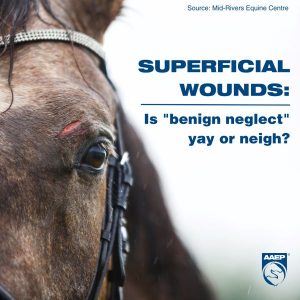Superficial Wounds: Is Benign Neglect Yay or Nay?
From AAEP, courtesy of Mid-Rivers Equine Centre:
How do you approach superficial wound care? Do you apply daily medications or are you in favor of “benign neglect”? Keep reading, the horse doctors at Mid-Rivers Equine Centre have some valuable information to share!
“First of all, let’s start by defining what a superficial wound is. A superficial wound is a cut, scrape, or abrasion that affects only the top layers of the skin. This means the wound is not deep enough to penetrate the underlying tissue and cause significant damage. While superficial wounds can be painful, they generally do not significantly threaten their health and well-being.
Now, to answer the question, should we be practicing ‘benign neglect’ when it comes to superficial wound care? Well, the answer is both yes and no.
On the one hand, many superficial wounds will heal independently without intervention. Although we recommend an initial cleaning of the injury—and additional cleaning should it become dirty—, unnecessarily medicating the wound daily can slow the natural healing process.
On the other hand, it’s important to note that not all superficial wounds are created equal. Some may be deeper than they appear and require medical attention to prevent infection or more severe complications. Additionally, if your horse has a compromised immune system or is prone to infections, it may be best to err on the side of caution and seek professional help.
Ultimately, the decision on how to treat a superficial wound should be based on a case-by-case basis. If you need more clarification about the severity of the injury or if it’s not healing as quickly as you’d like, be sure to contact your primary care veterinarian.”
AAEP also published a past article on Wound Management and Bandaging, which addresses the question of whether a would requires a vet or not. Click the link for the AAEP article by Erin Denney-Jones, DVM:











